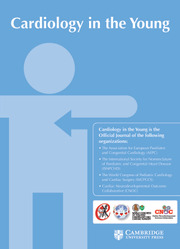No CrossRef data available.
Article contents
Detecting early markers of sepsis in paediatric patient with prolonged cardiopulmonary bypass time
Published online by Cambridge University Press: 28 July 2025
Abstract
Sepsis, a life-threatening organ dysfunction resulting from a dysregulated host response to infections, poses a critical threat. Cardiac surgery itself induces a robust inflammatory response, further exacerbated by cardiopulmonary bypass, causing notable clinical and physiological changes. Identifying sepsis early in the post-operative period with elevated septic markers becomes challenging, with delayed antibiotic intervention ultimately posing a fatal risk for the patient.
We performed a prospective observational cross-sectional study aimed at identifying sepsis markers that include total leucocyte count, absolute neutrophil count, platelet count, serum albumin, chest X-ray, blood, urine, and tracheal cultures, procalcitonin, c-reactive protein, serum lactate >2.5 mmol/l along with clinical parameters (fever, hypotension, tachycardia) on post-operative days 1, 3, 5, and 10 in paediatric patients undergoing cardiac surgery with prolonged cardiopulmonary bypass time >100 min.
Total leucocyte count, absolute neutrophil count, and platelet counts were not significant enough to detect early sepsis, especially in patients with prolonged cardiopulmonary bypass time. Chest X-ray was significant from post-operative day 3 onwards. Procalcitonin was significant from day 5, and C-reactive protein was significant only from day 10. Among the clinical parameters, fever, hypotension, tachycardia, and elevated lactate levels were significant from post-operative day 1 in the patients developing sepsis.
Neonates and infants faced a higher sepsis risk than older children. Longer cardiopulmonary bypass and aortic clamp times correlated with increased sepsis likelihood. Clinical factors outweighed laboratory indicators for early sepsis detection post-cardiac surgery, prompting prompt investigation and intervention.
Information
- Type
- Original Article
- Information
- Copyright
- © The Author(s), 2025. Published by Cambridge University Press


